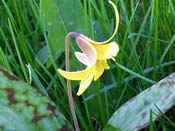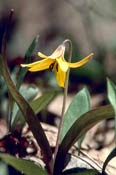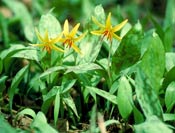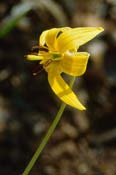
SCIENTIFIC NAME
Erythronium americanum
DESCRIPTION
Trout lilies are low-growing plants that form colonies of plants of different ages. The youngsters are flowerless and have only one leaf, while older plants produce two leaves and a single flower. A plant’s corm has to reach sufficient depths (10 to 20 centimetres below ground) before it will devote energy to making the additional parts.
RANGE
Native to Ontario, Quebec, New Brunswick and Nova Scotia.
HABITAT
They can be found in moist woods and meadows.
DIET
BEHAVIOUR
undefinedPRIMARY ECOSYSTEM ROLES
Photo Gallery
|
Article: Sarah Coulber
Images: Arlene Neilson, Margaret Coulber, & Corel |
|
We all have signs that tell us spring is here. For some, it is the red-winged blackbird calling or the sweet smell of the thawing earth. The sight of trout lilies poking through last autumn’s leaves is surely a sign for others. This early bloomer appears briefly in the spring, often before all the snow and ice has left the ground. It is a common wildflower of eastern Canada’s deciduous — and sometimes mixed — woods but can adapt to partially shaded areas of many gardens. (See below for other Canadian Erythronium species.) What’s in a name?
Its latin name, Erythronium americanum, is partly from the Greek word erythros, meaning “red.” This is a reference either to the red flower or the reddish blotching of some Erythronium species. Appearance Trout lilies are low-growing plants that form colonies of plants of different ages. The youngsters are flowerless and have only one leaf, while older plants produce two leaves and a single flower. A plant’s corm has to reach sufficient depths (10 to 20 centimetres below ground) before it will devote energy to making the additional parts. Despite being a low-growing plant that can easily blend in with its environment, the trout lily’s fleshy green leaves with purple mottling make it easy to recognize. Its graceful yellow flower sits atop a solitary stem and droops towards the ground. Its petals, however, curl upwards, revealing the bright yellow of the inner petals. As a member of the lily family, the trout lily displays a common characteristic of having three petals and three petal-like sepals.Be sure to watch out for these common spring flowers before June has passed and their above-ground parts have withered away. After that, they will be focusing their energies on spreading underground and making new shoots for next year. Uses Trout lily leaves and corms were traditionally boiled and eaten and, as with many things in life, eaten in moderation for too many could cause mild vomiting. (Caution: We are not recommending the use of these plants for medicinal or food purposes. Many plants are poisonous or harmful if eaten or used externally. The information on food and medicinal value is only added for interest. This information has been gathered from books and its accuracy has not been tested.) Propagation This is a plant that relies more on the spreading abilities of its underground root system (corms) than on seed production from its flowers. In fact, it takes a few years for a plant to be mature enough to produce a flower and seeds. Trout lilies have recruited the help of ants, who eat a nutritious appendage attached to each seed and leave the rest to germinate. If you wish to propagate your trout lilies from seed, you will want to follow nature’s lead, at least as far as temperature is concerned. Keep your seeds moist and give them a few months of warm followed by a few months of cold, similar to the seeds falling on the ground at the beginning of summer and receiving the summer warmth and winter cold before sprouting the following spring. Wildflowers sometimes stagger their germination over several years, so you might want to sow a few extra seeds to avoid disappointment.These plants will naturally spread by forming vast colonies. Some wild colonies are reputed to be as old as the trees around them — two or three hundred years! Despite its ability to spread, the trout lily is not considered an aggressive spreader but rather a delight to have in one's garden. Care Trout lilies grow in moist, fertile woods but can adapt to growing in many types of gardens. Ideally, they should be planted amidst two or more deciduous trees that are large enough to provide shade or partial shade once their leaves emerge. As they are above ground for only a short time, the only care you have to be concerned with is choosing a suitable spot. It should offer sun in the spring — to warm the earth and provide enough light for the lilies to make and store food — and shade or partial shade in the summer. Trout lilies are lovely interplanted with other spring ephemerals such as white-flowered bloodroot or pinkish spring beauties. They might even be happy in a section of your lawn, but be sure to let the grass grow until the plant’s aerial parts have withered away for the year. If you buy corms, make sure they are firm and free of mould. Plant them in rich, well-drained soil in the fall, about 5 to 7.5 centimetres deep. Do not store them for future years, as they tend to go soft and mouldy. If you are buying potted plants instead, transplant them in the spring. Remember to buy from nurseries that guarantee nursery-propagated seeds or plants as our native plants and habitats are at risk from being depleted. If you choose to improve the soil with fertilizer, compost is best. Trout lily (Erythronium americanum)
Some Other Canadian Erythronium Species White trout lily (E. albidum)
Coast fawn lily, Pink fawn lily (E. revolutum)
Yellow avalanche lily (E. grandiflorum)
White avalanche lily (E. montanum)
White fawn lily (E. oregonum)
Growing native plants can save time and money and be rewarding both to the eye and to our wildlife neighbours. To learn more about growing native plants in your garden, visit http://cwf-fcf.org/en/resources/online-articles/news/habitat/gardening-with-native-canadian-plants.html. |




